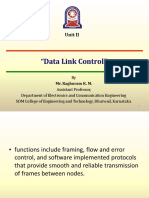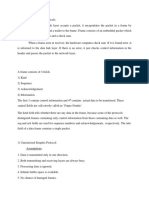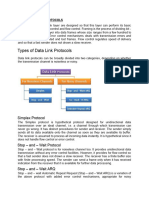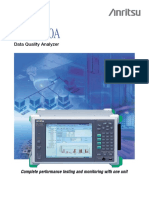Sliding Window Protocols
Sliding Window Protocols
Uploaded by
IT sacwcCopyright:
Available Formats
Sliding Window Protocols
Sliding Window Protocols
Uploaded by
IT sacwcCopyright
Available Formats
Share this document
Did you find this document useful?
Is this content inappropriate?
Copyright:
Available Formats
Sliding Window Protocols
Sliding Window Protocols
Uploaded by
IT sacwcCopyright:
Available Formats
Sliding Window Protocols:
• In the previous protocols, data frames were transmitted in one direction only. In most
practical situations, there is a need for transmitting data in both directions. • One way of
achieving full-duplex data transmission is to have two separate communication channels and
use each one for simplex data traffic (in different directions). • If this is done, we have two
separate physical circuits, each with a ''forward'' channel (for data) and a ''reverse'' channel
(for acknowledgements).
• In both cases the bandwidth of the reverse channel is almost entirely wasted. • In effect, the
user is paying for two circuits but using only the capacity of one. • A better idea is to use the
same circuit for data in both directions.
• Although interleaving data and control frames on the same circuit is an improvement over
having two separate physical circuits, yet another improvement is possible. • When a data
frame arrives, instead of immediately sending a separate control frame, the receiver restrains
itself and waits until the network layer passes it the next packet (this is possible only when
both parties mutually transfer data).
• The acknowledgement is attached to the outgoing data frame (using the ack field in the
frame header). • In effect, the acknowledgement gets a free ride on the next outgoing data
frame. • The technique of temporarily delaying outgoing acknowledgements so that they can
be hooked onto the next outgoing data frame is known as piggybacking.
• The principal advantage of using piggybacking over having distinct acknowledgement
frames is a better use of the available channel bandwidth. • Other advantage is ack field in
the frame header costs only a few bits, whereas a separate frame would need a header, the
acknowledgement, and a checksum.
• However, piggybacking introduces a complication not present with separate
acknowledgements. How long should the data link layer wait for a packet onto which to
piggyback the acknowledgement? If the data link layer waits longer than the sender's
timeout period, what happens??? The frame will be retransmitted.
• A solution to the above problem is: waiting a fixed number of milliseconds. • If a new
packet arrives quickly, the acknowledgement is piggybacked onto it otherwise, if no new
packet has arrived by the end of this time period, the data link layer just sends a separate
acknowledgement frame.
• Three protocols have been proposed to overcome the above mentioned problems. • These
three protocols are bidirectional protocols that belong to a class called sliding window
protocols. • In all sliding window protocols, each outbound frame contains a sequence
number, ranging from 0 up to some maximum. The maximum is usually 2 N-1.
• The essence of all sliding window protocols is that at any instant of time, the sender
maintains a set of sequence numbers corresponding to frames it is permitted to send. • These
frames are said to fall within the sending (sender) window. • Similarly, the receiver also
maintains a receiving (receiver) window corresponding to the set of frames it is permitted to
accept.
• In sliding window method of flow control, the sender can transmit several frames before
needing an acknowledgement. • The receiver acknowledges only some of the frames, using a
single ACK to conform the receipt of multiple data frames. • The sliding window refers to
imaginary boxes at both the sender and receiver. School of Computing Science and
Engineering Course Code : BCSE2370 Course Name: Data Communication and networking
Name of the Faculty: Ms. Heena Khera Program Name: BTech
0 1 2 3 4 5 6 7 8 9 10 11 12 13 14 Sliding Window
• To keep track of which frame has been transmitted and received , frames are numbered
modulo- n , which means they are numbered from 0 to n-1. • For example if n=8, the frames
are numbered 0,1,2,3,4,5,6,7,0,1,2,3,4,5,6,7,0,1….. • The size of the window is n-1.
• When the receiver sends an ACK, it includes the number of the next frame it expects to
receive. For example if the ending frame is 4, the receiver send an ACK containing the
number 5. • When the sender sees an ACK with the number 5, it knows that all frames up
through number 4 have been received.
• The three protocols are : 1. A One-Bit Sliding Window Protocol. 2. A Protocol Using Go
Back N. 3. A Protocol Using Selective Repeat.
One-Bit Sliding Window Protocol: • Before tackling the general case, let us first examine a
sliding window protocol with a maximum window size of 1. • Such a protocol uses stop-and-
wait since the sender transmits a frame and waits for its acknowledgement before sending
the next one. • Below protocol depicts the same(One-Bit Sliding Window Protocol).
You might also like
- Mid ServerDocument2 pagesMid ServerranjithgottimukkalaNo ratings yet
- KUKA Ethernet/IP 2.0: Controller OptionDocument51 pagesKUKA Ethernet/IP 2.0: Controller Optionbrenobenilson santosNo ratings yet
- ZTE H298A Admin ManualDocument19 pagesZTE H298A Admin Manualjosefm665699No ratings yet
- DDL Sliding Window ProtocolsDocument20 pagesDDL Sliding Window Protocolsshaikmaseera1229No ratings yet
- EdlprotocolDocument7 pagesEdlprotocolMrs.Minu Meera MNo ratings yet
- Sliding window protocolDocument15 pagesSliding window protocoldeekshithauppu41No ratings yet
- Unit 5 Data LinkDocument46 pagesUnit 5 Data LinkSahulNo ratings yet
- Cs3591-Unit 5Document27 pagesCs3591-Unit 5reshma.rNo ratings yet
- DLL Design Issues - Part3Document30 pagesDLL Design Issues - Part3J PNo ratings yet
- Module 2 Part 2Document43 pagesModule 2 Part 2leemong335No ratings yet
- Data Link Control: B. R. Chandavarkar CSE Dept., NITK SurathkalDocument37 pagesData Link Control: B. R. Chandavarkar CSE Dept., NITK SurathkalSoham Raje PatilNo ratings yet
- Data Link Control: Variable-Size FramingDocument21 pagesData Link Control: Variable-Size FramingLE-418 NIKHILESHWARNo ratings yet
- Chapter Seven Error - &flow - Control - MechanismsDocument50 pagesChapter Seven Error - &flow - Control - MechanismsNaol LamuNo ratings yet
- Cs3591 CN Unit 5 NotesDocument27 pagesCs3591 CN Unit 5 Notesramyadevi100% (1)
- Mod II Datalink LayerDocument93 pagesMod II Datalink Layerkiranmaidevarakonda08No ratings yet
- Chapter 11Document83 pagesChapter 11Preethi RaoNo ratings yet
- Edu Eng Unit 5Document29 pagesEdu Eng Unit 5SahulNo ratings yet
- UNIT3Document56 pagesUNIT3BabuNo ratings yet
- Unit-5 Datalink LayerDocument8 pagesUnit-5 Datalink LayerNawal K SahNo ratings yet
- CCN Unit 2Document60 pagesCCN Unit 2Neha ShankarNo ratings yet
- Elementary Data Link ProtocolsDocument4 pagesElementary Data Link ProtocolsIT sacwcNo ratings yet
- Chapter Four - NewDocument33 pagesChapter Four - NewEthio DotNetDeveloperNo ratings yet
- CNS Co 2Document90 pagesCNS Co 2PUVVALA SIRISHANo ratings yet
- CCN Unit 2Document129 pagesCCN Unit 2Shreya PadukoneNo ratings yet
- CH 6-The Transport LayerDocument62 pagesCH 6-The Transport Layerrushalin70% (1)
- Data Link Layer - Unit3 1Document72 pagesData Link Layer - Unit3 1Bikash KhanalNo ratings yet
- DCN Unit-5 - RAKDocument61 pagesDCN Unit-5 - RAKRishiNo ratings yet
- Datalink LayerDocument26 pagesDatalink Layertanmay2020anandNo ratings yet
- CN Manual Sliding WindowDocument6 pagesCN Manual Sliding WindowSneha KanwadeNo ratings yet
- CNDocument21 pagesCNShashank RNo ratings yet
- Elementary Data Link ProtocolsDocument11 pagesElementary Data Link ProtocolsJayaMadhavNo ratings yet
- Data Link LayerDocument56 pagesData Link Layershuklaraghv555No ratings yet
- Unit 4 Notes - Computer CommunicationDocument24 pagesUnit 4 Notes - Computer CommunicationKARAN PAWAR (RA2011032020019)No ratings yet
- Unit 5Document41 pagesUnit 5rpssuvethaNo ratings yet
- Sliding Window ProtocolDocument14 pagesSliding Window ProtocolvickysmusiceditzNo ratings yet
- Elementary Data Link ProtocolsDocument23 pagesElementary Data Link ProtocolsRekha V R100% (1)
- Unit-3-The Data Link Layer (Edited)Document24 pagesUnit-3-The Data Link Layer (Edited)Neeraj KumarNo ratings yet
- L31 - Data Link ControlsDocument27 pagesL31 - Data Link ControlsShivam KushwahaNo ratings yet
- CCN Unit 2 - IncompleteDocument35 pagesCCN Unit 2 - IncompleteShreya PadukoneNo ratings yet
- Unit 2Document152 pagesUnit 2jassimjinnah91No ratings yet
- Introduction To Transport LayerDocument57 pagesIntroduction To Transport LayerkjhofboaNo ratings yet
- Protocol SuiteDocument19 pagesProtocol Suiteakhil kolluriNo ratings yet
- Chapter 5Document81 pagesChapter 5pratham.sagittarusNo ratings yet
- Data Link Layer ProtocolsDocument53 pagesData Link Layer ProtocolsAkshay GuptaNo ratings yet
- Computer Networking Unit 2Document53 pagesComputer Networking Unit 2sadiq AadilNo ratings yet
- Data Communications and NetworkingDocument48 pagesData Communications and NetworkingrohithellooNo ratings yet
- Data Communication Lab ManualDocument35 pagesData Communication Lab ManualKapil DhamaNo ratings yet
- Module 3 2Document23 pagesModule 3 2SINGH NAVINKUMARNo ratings yet
- Lec10 11Document63 pagesLec10 11Luqman ahmadNo ratings yet
- CN (1)Document23 pagesCN (1)Shashank RNo ratings yet
- Computer Network Unit 2 NotesDocument11 pagesComputer Network Unit 2 Notesankitupadhyay2241No ratings yet
- CNS Unit 3Document207 pagesCNS Unit 3Parth Gadewar100% (1)
- Chap 3 - Linklayer - BCADocument79 pagesChap 3 - Linklayer - BCAajitsah110920No ratings yet
- m2 UpdatedDocument89 pagesm2 UpdatedmtbnogrojNo ratings yet
- 1.flow ControlDocument15 pages1.flow ControlAntonette SherleyNo ratings yet
- Real Time CommunicationDocument41 pagesReal Time Communicationgurusodhii100% (2)
- Txc-Chapter 3 Setembre 2020Document123 pagesTxc-Chapter 3 Setembre 2020radnom mail laverdadNo ratings yet
- Flow and Error Control - 4Document14 pagesFlow and Error Control - 4nasserjk.93No ratings yet
- Lectures 8-10 Data Link Layer: Computer CommunicationsDocument24 pagesLectures 8-10 Data Link Layer: Computer CommunicationsPrabhat SinghNo ratings yet
- 2024 Flow ControlDocument79 pages2024 Flow ControlTharun SvNo ratings yet
- Elementary Data Link ProtocolsDocument61 pagesElementary Data Link ProtocolsRekha V RNo ratings yet
- Model 1310 Network Installation ManualDocument62 pagesModel 1310 Network Installation ManualRicardo Vazquez SalinasNo ratings yet
- 350 401 DemoDocument7 pages350 401 DemoLuis PerezNo ratings yet
- Netgear CG3000D User Guide PDFDocument52 pagesNetgear CG3000D User Guide PDFcanatalNo ratings yet
- FTTH-FTTB PTP Vs PonDocument40 pagesFTTH-FTTB PTP Vs PonWalter Ruiz PorrasNo ratings yet
- A Smarter Way: For Your Broadband LifeDocument2 pagesA Smarter Way: For Your Broadband Lifegpon onu olt bt-ponNo ratings yet
- 2.9.1 Packet Tracer - Basic Switch and End Device Configuration Jorge MendezDocument5 pages2.9.1 Packet Tracer - Basic Switch and End Device Configuration Jorge MendezJorge MéndezNo ratings yet
- MD1230ADocument16 pagesMD1230AramonNo ratings yet
- Ethernet PosterDocument1 pageEthernet Posterilyas RimaNo ratings yet
- Hailun SDocument30 pagesHailun SmohdfareeduddinNo ratings yet
- APV App WebUIDocument317 pagesAPV App WebUIneo thomasNo ratings yet
- Free RadiusDocument21 pagesFree RadiusrapleeNo ratings yet
- Lab 3 Ahmad AbdullahDocument6 pagesLab 3 Ahmad AbdullahSweety KhanNo ratings yet
- 174CEV20040 - MB+ User GuideDocument152 pages174CEV20040 - MB+ User GuideChristopherNo ratings yet
- Hcie-R&s Lab Mock Exam 1Document10 pagesHcie-R&s Lab Mock Exam 1Anonymous 4Db63nJ4G100% (1)
- Configure Eap Tls Flow With IseDocument24 pagesConfigure Eap Tls Flow With IseKash BarlasNo ratings yet
- Amazon Virtual Private Cloud: Network Administrator GuideDocument224 pagesAmazon Virtual Private Cloud: Network Administrator GuidebobwillmoreNo ratings yet
- Final Exam Comp 213Document11 pagesFinal Exam Comp 213Amanjot SidhuNo ratings yet
- Imaster NCE-Campus V300R019C10 Training - APRIL2020Document30 pagesImaster NCE-Campus V300R019C10 Training - APRIL2020julioNo ratings yet
- Network Pentesting Gaining Access 1 PDFDocument17 pagesNetwork Pentesting Gaining Access 1 PDFPhilippNo ratings yet
- SubnettingDocument38 pagesSubnettingKenneyNo ratings yet
- Arris D5™: Universal Edge QAM (UEQ)Document4 pagesArris D5™: Universal Edge QAM (UEQ)Burim QehajaNo ratings yet
- A10 Sce70164 enDocument2 pagesA10 Sce70164 enAlexandre GiovaneliNo ratings yet
- Ip10g Cli User Guide 662Document97 pagesIp10g Cli User Guide 662Ciobanita Paul Adrian65No ratings yet
- Using Wireshark To Capture and Analyze Network DataDocument23 pagesUsing Wireshark To Capture and Analyze Network DataAtikah Ibno SofaNo ratings yet
- RTN910ADocument2 pagesRTN910AJorge Falla LopezNo ratings yet
- Installation and Operating Manual: SEN 40 / SAN 40 NTP MovementDocument24 pagesInstallation and Operating Manual: SEN 40 / SAN 40 NTP MovementbadruddojamohdNo ratings yet
- Cns Lab 3Document9 pagesCns Lab 3towhidulNo ratings yet

























































































